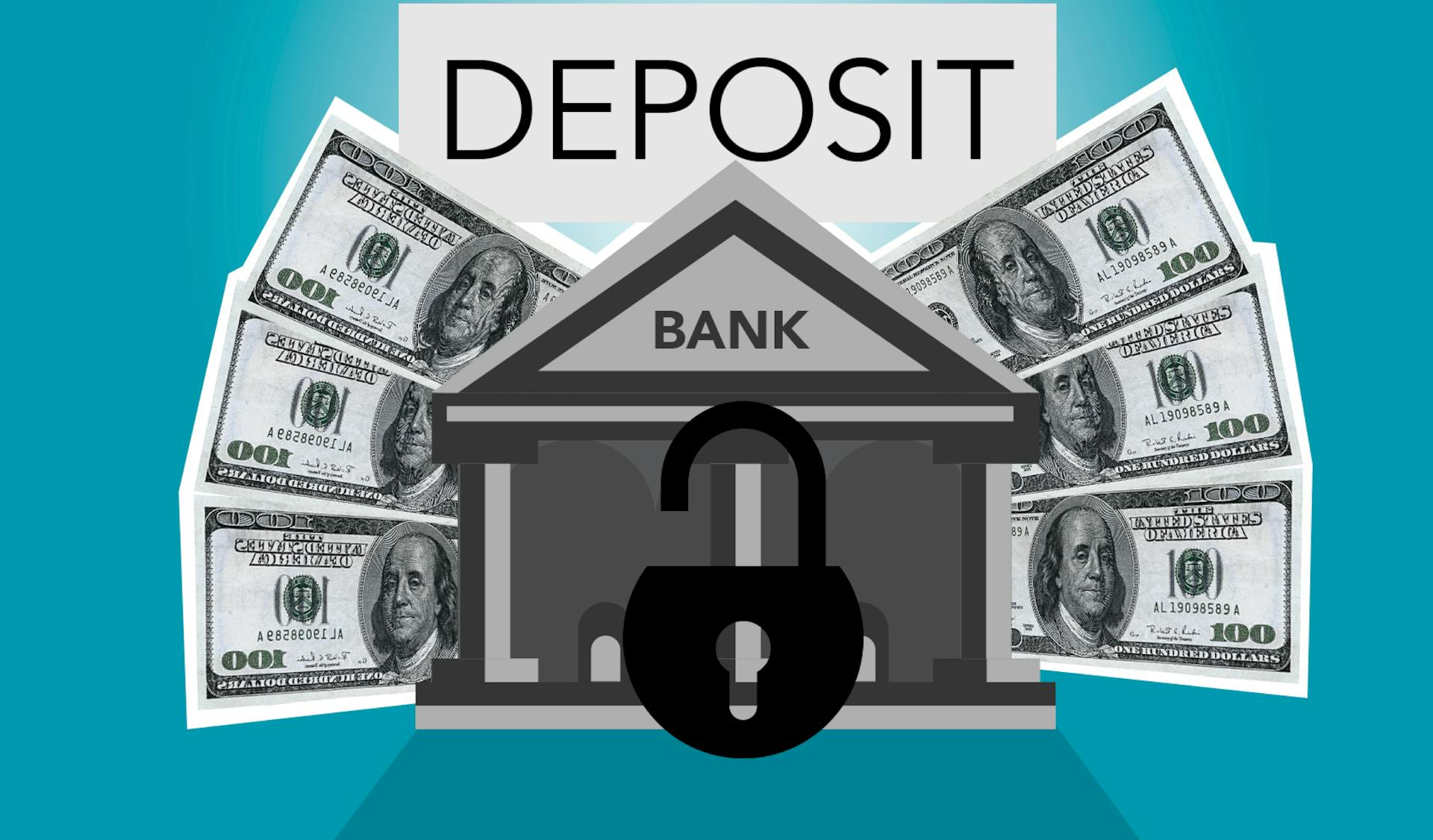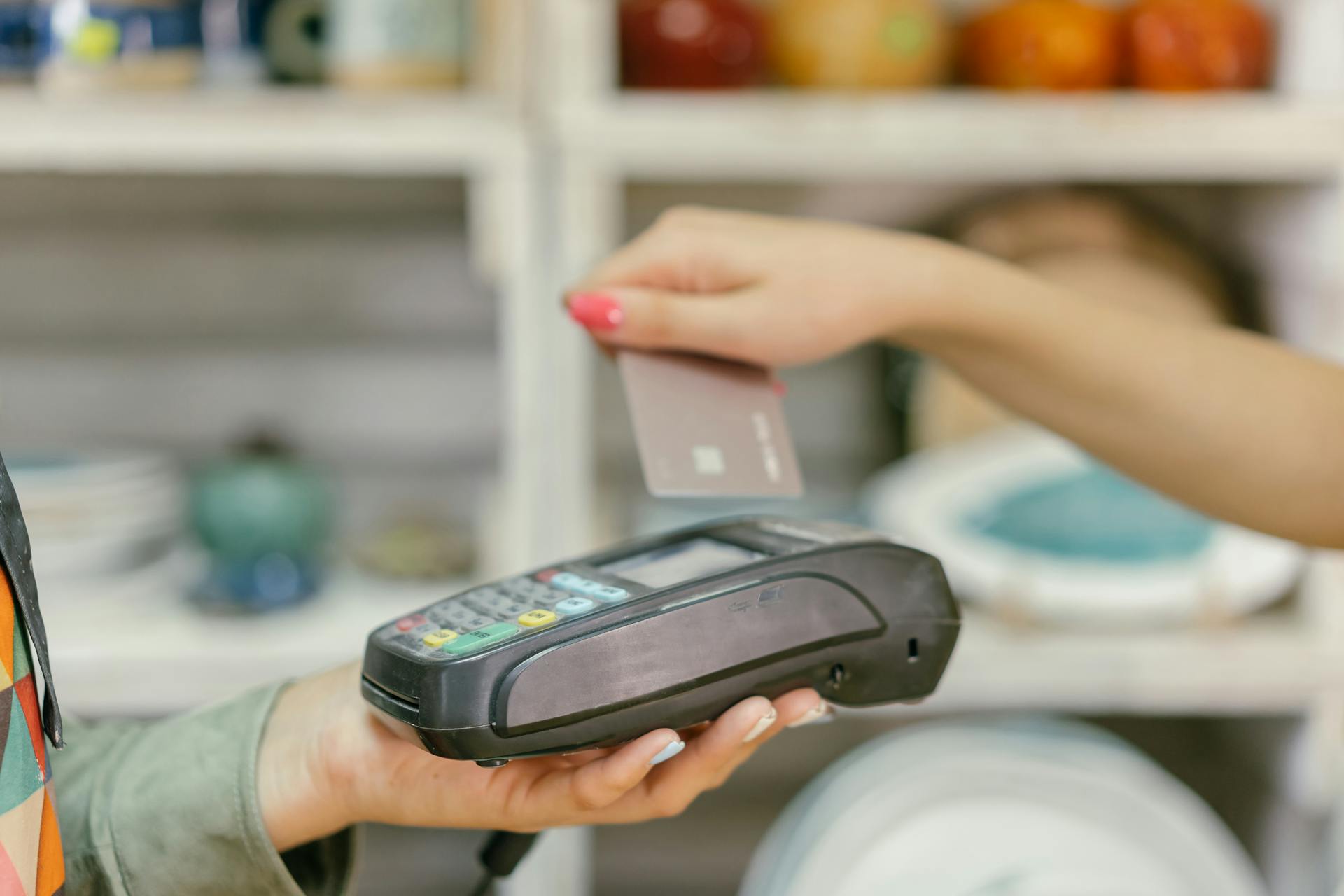
An echeck is a digital version of a paper check, allowing you to pay bills and make purchases online. It's a convenient way to manage your finances, and you can even set up recurring payments to make it easier to stay on top of your expenses.
An echeck works by routing your payment through the Automated Clearing House (ACH) network, which is a secure and reliable system for processing electronic transactions. This network is used by millions of businesses and individuals every day.
To use an echeck, you'll need to provide your bank account information, including your routing number and account number. This information is used to verify your account and ensure that the payment is processed correctly.
On a similar theme: Echeck Check Number
What Is an E-Check?
An e-check is an electronic payment method that allows money to be transferred directly from one bank account to another. It's a digital version of a traditional paper check.
The e-check process is facilitated by the Automated Clearing House (ACH) network, which enables fast and secure transactions. This is a significant improvement over paper checks, which involve multiple steps and take longer to process.
E-checks rely on the same information as paper checks, including the bank routing number, account number, and authorization from the payer.
Readers also liked: Us Bank Echeck
How Does It Work?
An e-check is a convenient and secure way to make payments online. It's an electronic version of a traditional paper check.
To initiate an e-check payment, you need to provide your bank routing number, account number, email address, and authorization. This information is sent directly to the payee's financial institution.
The e-check payment process is faster than traditional paper checks, typically taking one to three business days to complete. This is because e-checks are processed electronically through the ACH network.
The ACH network is responsible for transmitting the payment from the payer's bank account to the payee's bank account. This process is automatic and secure.
Once the payment is initiated, you'll receive a payment receipt from the online system. The payment amount is then deposited into the company's bank account.
With e-checks, fewer people come into contact with sensitive financial information, reducing the risk of fraud. This is a significant advantage over traditional paper checks.
Broaden your view: Send Echeck Online Instantly
What Types of Payments Can You Make
You can make various types of payments with eChecks, including rent and mortgage payments, which are often high-cost items.
Merchants pay a smaller fee to process eCheck payments compared to credit card payments, making it a cost-effective option for high-cost transactions.
High-cost monthly fees, such as legal retainers or fitness memberships, are also commonly paid via eCheck.
This payment method is ideal for recurring payments that require a direct transfer of funds from one account to another.
Benefits and Safety
eChecks offer numerous benefits, including simplified digital transactions that streamline online payments and eliminate the hassle of physical checks. This enables swift and secure transactions.
With eChecks, you can make payments worldwide with ease and efficiency, transcending geographical boundaries. This is especially useful for businesses that operate globally.
eChecks can be integrated with internal financial software, optimizing record-keeping and enhancing organizational efficiency. This can help reduce administrative burdens and increase overall operational efficiency.
Automated processing minimizes human error, ensuring accuracy and reliability in financial transactions. This is a significant advantage over traditional payment methods.
Real-time tracking capabilities empower users to monitor eCheck transactions effortlessly, enhancing transparency and control. This can help you stay on top of your finances and make informed decisions.
eChecks are also cost-effective, offering significant cost savings compared to traditional payment methods. This can help reduce transaction fees and administrative expenses.
eChecks are one of the safest types of online payments, and may even be safer than traditional checks. This is because they are in digital form and unable to be misplaced, and fewer individuals are involved in processing an eCheck.
Here are the key differences between eChecks and paper checks:
Processing and Receiving
Processing and Receiving eChecks is a straightforward process that can be done through a payment gateway. This gateway encrypts the banking information, making it secure and reducing the risk of fraud.
To process an eCheck, the merchant uses their standard payment gateway, which encrypts the payment information. This information then travels between the merchant and customer banks, and the funds exit the customer's account through the ACH network.
The eCheck payment process involves four stages: authorization, processing, finalization, and deposit. The authorization stage protects the payer by ensuring the transaction is valid, while processing involves a funds transfer between one bank account and another.
To receive an eCheck, you'll need a payment processing provider that specializes in online transactions. This provider can help you set up your account and walk you through the details of eCheck processing.
Here are the four stages of the eCheck payment process:
- Authorization: Ensures the transaction is valid
- Processing: Transfers funds between bank accounts
- Finalization: Verifies account information
- Deposit: Completes a successful transaction
With eCheck transactions, you can enjoy faster speed and increased security, as encrypted information travels between parties. This makes eChecks safer and more reliable than traditional payment methods.
Overall, processing and receiving eChecks is a simple and secure process that can benefit both businesses and customers alike.
vs. Other EFTs
An eCheck is just one type of electronic funds transfer (EFT). There are several other types of EFTs that serve different purposes.
An eCheck is generally processed 3 to 5 business days after it's issued, which is a bit slower than some other EFTs.
eChecks are similar to ACH payments, but they're often used for one-time or recurring payments, whereas ACH payments are commonly used for direct transfers between checking accounts.
Here's a comparison of different EFTs:
As you can see, each type of EFT has its own unique characteristics and processing times.
How to Use and Pay
Paying with an eCheck is a convenient and secure way to make payments online. You can use an eCheck for various types of payments, such as mortgage payments, monthly rent payments, and car loan repayments.
To pay with an eCheck, you'll need to provide your routing number and account number, which will be sent directly to the payee's financial institution. This protects both you and the recipient from potential fraud.
You can find eCheck forms as a payment option on company websites or your bank's online Bill Pay portal. Some common types of payments that can be made using an eCheck include membership fees, tax payments, credit card payments, and utility payments.
You might enjoy: Echeck Online Stores
How to Pay
Paying with an eCheck is a secure way to make payments, as it reduces the risk of fraud compared to traditional paper checks. Fewer people come into contact with sensitive financial information, as routing numbers and account numbers are sent directly to the payee's financial institution.
You can use an eCheck for various types of payments, including mortgage payments, monthly rent payments, car loan repayments, membership fees, tax payments, credit card payments, and utility payments.
Paying with an eCheck is often offered as a payment option on a company's website or your bank's online Bill Pay portal.
Recurring Payments
Recurring Payments are a breeze with eChecks. You can use them for regular payments like rent, mortgage, or car loan repayments. Property managers often ask tenants to fill out a recurring eCheck rent payment form, which automatically deducts rent from their checking account on a certain day each month.
eChecks are actually one of the most popular types of recurring payment. They're also known as recurring ACH payments or direct debits.
You can use eChecks for recurring payments like:
- Mortgage payments
- Monthly rent payments
- Car loan repayments
- Membership fees
- Tax payments
- Utility payments
This makes it easy to set up automatic payments for regular bills, so you don't have to worry about missing a payment.
Insights and Information
An eCheck is a digital payment method that may be useful in several situations. With the help of technology, online payment processing is convenient whether you need it for personal or business reasons.
An eCheck is a payment made directly from an individual's checking account, but the payment is carried out digitally. This makes it a great option for those who want to avoid writing a traditional check.
An eCheck is one of several types of electronic funds transfers (EFTs) available through online banking.
Explore further: Shop Online Using Echeck
Quick Insights
An eCheck is a digital payment method that's useful in various situations.
It's essentially an electronic version of a paper check, making it a convenient option for online transactions.
An eCheck is a payment made directly from an individual's checking account, but the payment is carried out digitally.
This digital payment method is one of several types of electronic funds transfers (EFTs) available through online banking.
Here are some key facts about eChecks:
- An eCheck is a digital payment method.
- An eCheck is a payment made directly from an individual's checking account.
- An eCheck is one of several types of electronic funds transfers (EFTs) available through online banking.
How an AI Works
An AI goes through several steps to process information and provide answers.
It starts by receiving input from a user, which is then analyzed and understood through complex algorithms.
Money can be transferred through the automated clearing house (ACH) network, just like an eCheck.
The AI then uses this information to generate a response, which is based on the data it has been trained on.
Money is drawn from a bank account and transferred through the ACH network, as is the case with an eCheck.
The AI's response is then presented to the user, who can ask follow-up questions or seek further clarification.
The process of creating an eCheck on a digital platform involves entering key personal and financial information.
This back-and-forth process continues until the user's query is fully addressed.
On a similar theme: Is Echeck the Same as Ach
Frequently Asked Questions
How do I pay with an electronic check?
To pay with an electronic check, simply fill out the online payment portal with your bank account number and routing number, then authorize the payment. The payment processor will then send a request to the ACH network to process the payment.
Does electronic check clear immediately?
No, eChecks typically take 4-7 business days to clear, not immediately. However, the exact processing time may vary depending on the specific circumstances.
How long does an eCheck take to process?
An eCheck typically takes 3-5 business days to process, as it uses the Automated Clearing House network to transfer funds in batches. This processing time may vary depending on the specific transaction and bank involved.
Sources
Featured Images: pexels.com


